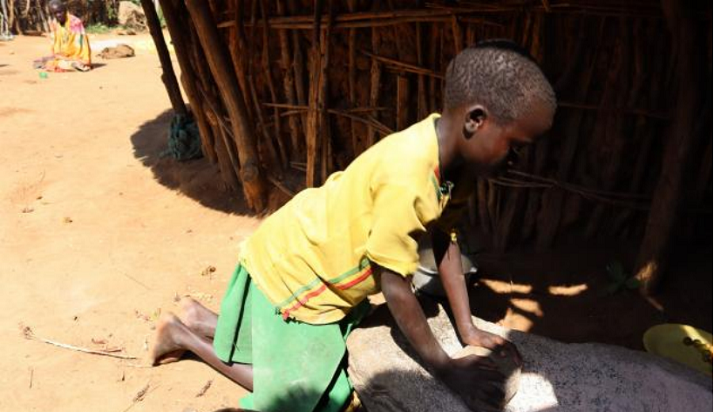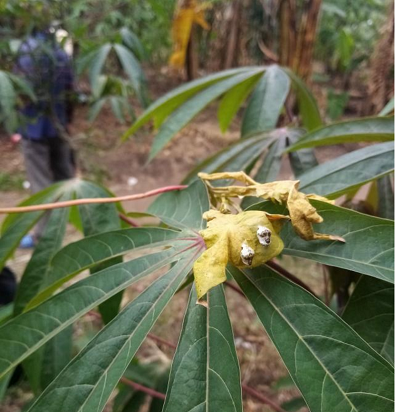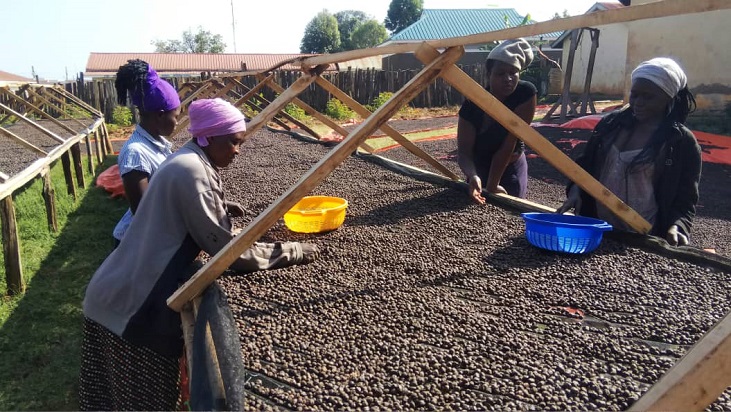Angerikori grinding millet
Uganda’s Capital City, Kampala still grapples with children who flock to the streets and major traffic junctions to beg money from road users.
According to Kampala Capital City Authority (KCCA), there are over 1000 such children, the majority aged between 3 to 16 years.
Wearing a vulnerable face, they ask for as little as Shillings 100 from the road users.
Of recent, the street children have spiced up the trade as they move with small towels they use to dust cars and motorcycles in the traffic jams and after demand Shillings 500 for their service.
In June 2022, the Ministry of Gender, Labour and Social Development revealed that over 90 percent of the children come from Napak District in North Eastern Uganda in the Karamoja sub-region, which is over 500kms from Kampala.
But according to data captured by the Koblin Youth Rehabilitation Center where government rehabilitates children taken from the streets, not all Napak is guilty.
Robert Odida, the Center in charge, says that over 90 percent of these children come from Lopeei and Lokopo Sub counties, approximately 30km each from the district headquarters.
Our reporter visited some areas in the two sub Counties to get a picture of how life is there and understand the factors that could be pushing children in their hundreds to Kampala Streets.
Our reporter found Angerikori, 8, grinding millet in the scorching sunshine at noon on a traditional stone with sweat flowing down her cheeks to make flour for breakfast for her family.
Angerikoli is one of the 260 children who were rescued from the streets of Kampala on August 1, 2022, in an operation conducted by KCCA, the Ministry of Gender Labor and Social Development and Police.
She was reunited with her family, in Lolita village Lokopo Subcounty in Napak District.
An orphan, Angerikori has been under the care of her uncle, Paul Oboi for much of her life.
In May, together with her cousin aged 5, they escaped to Kampala with their auntie Betty Longora, 23.
She became one of the children who were directly brought to the streets by their relatives or sold to traffickers for some money.
“I asked my auntie to come with me such that I could get a job and earn an income. We started begging on the streets. Life was not good,” recollects Angerikori, breathing hard from tiredness.
They escaped while Oboi was hospitalized for more than a month to come to Kampala where they had been promised jobs, narrates Angerikori’s uncle.
Oboi is a father of four and guardian to six children of his late siblings. He also lives with and cares for his parents, both shying their 90s.
At one corner of the compound, Oboi’s frail and sick-looking father lay on earth, covered in their traditional garb, a checkered blanket. “He’s not sick, just a little cough,” Oboi said of his old man, who could barely respond to our greeting.
Oboi’s mother also sat at the entrance of one of their four huts in the compound, her face, like her husband’s wrinkled while her body also looked weak from old age.
These are the people with whom Oboi left his children when he went to the hospital in May this year.
When he left, their three granaries were almost empty. The family soon went without food forcing the children to look for alternative means of survival.
Oboi and his niece point to hunger as a key factor that led the young ones to join their auntie to beg on Kampala Streets.
Hunger here is a result of mainly two factors, unreliable rainfall and insecurity posed by cattle rustlers in the Karamoja sub-region. Uganda, which experiences a largely tropical climate has two rainy seasons each year. The seasons run from March to May and September to December.
But the Karamoja sub-region has been characterized by harsh climatic conditions with frequent droughts, high temperatures, and hot and dry winds all year round.
Previously known to have a single long rainy period between April and November, Karamoja has experienced erratic rains for close to two years now, says a senior resident.
This has affected the yield from the farms. On close to an acre of land, Oboi’s family planted millet and sunflower, the two most common crops in the area. They should be harvesting soon, but a tour through the garden reveals an awaiting poor harvest, the crops having starved from the rains.
Insecurity
The Insecurity in Lokopo and Lopeei Subcounty as is in other neighboring sub-counties is posed by cattle rustlers.
Oboi narrates how five years ago, more than 50 of his father’s cattle were raided.
Oboi later acquired two oxen from his saving from selling fish, but these too were raided from the Lokopo Army barracks where he had kept them.
When we arrived at Oboi’s home, he was setting off for a nearby forest to cut trees for firewood and make charcoal for sale.
It takes more than a week to cut trees, hip, and burn them to produce charcoal sold at 40,000 Shillings a sack. Charcoal burning and fishing are the two main income-generating activities for families here.
But Moses Lochen, 42, the LC 1 Chairman for Karugumeri village in Lokitae parish Lokopo Subcounty, says that forests are now hiding places for warriors waiting to raid, hence making them dangerous to the residents.
Lochen describes the warriors as ruthless killers who kill even those who have identified them. They plan their attacks in isolated places like forests and mountains and strike late in the evening or in the wee hours of the morning.
For safe custody of their animals, residents in Lokopo and Lopeei keep them at Lokopo army barracks and Lopeei military brigade respectively. Lowezet Tarchiriyo, a kraal leader in Lolita village, says that communities also graze their animals in larger groups and use nearby pastures for fear of warriors.
There are over a thousand animals in the barracks, but their security is still not guaranteed as Tarchiriyo explains that warriors raid even from the barracks. The warriors have guns locals say they acquire from communities across the border in Kenya and South Sudan.
A parish chief in Lopeei Subcounty who preferred to remain anonymous for fear of being targeted by warriors says that barely a week ago, warriors attacked the Lopeei army brigade and took animals.
The army pursued them shooting one of the raiders in the head. The man who was later identified as a Subcounty speaker from the Moroto district destroyed his phone before taking his life.
Karamajongs in the subregion raid each other but are also attacked by Turkana, Pokot, and Dinkas from Kenya and South Sudan. For more than a decade, Uganda ran a disarmament exercise taking guns away from the Karamoja people.
The exercise was however halted and for two years reports of evasion were high. This prompted President Yoweri Museveni to order the relaunch of offensive disarmament operations in Karamoja on June 24th last year. A year later, Anti-Stock Theft Unit (ASTU), would report recovering 291 guns and 393 warriors killed during the exercise.
But Uganda’s success is hampered by the little efforts by Kenya and South Sudan to disarm their pastoralists who often evade Uganda’s territory and raid animals from the Karamajongs.
During raids, not only animals are taken but lives are lost as both sides use force to keep the animals. Cattle keeping is a men’s job here, making them the most killed gender during the raids, leaving behind widows and orphans.
One old man in Lorengechora Subcounty was killed while he pursued raiders to save his animals. He left behind 40 widows, with over 50 young orphans. With no animals to milk or sell, and crops dying due to lack of rain, the mothers push their children to the streets to seek for sustenance.
Access to Education
According to the Children’s Act, as amended, it is the right of a child to acquire an education and a duty of a parent or guardian to ensure that.
In 1997, the government introduced Universal Primary Education in a bid to reduce illiteracy rates and poverty in the Country. Children in this program are funded by the state.
According to District Education Officer Joyce Nakoya, there are only four and two schools in Lokopo and Lopeei Subcounties respective. These schools are on average seven kilometers away from each other, forcing children to trek more than 10Km to and from school. The distance is long, she says, adding that this has affected the number of children going to school.
In Lopeei Subcounty, Lopari Primary School has only one class, Primary One, and has 417 pupils while Lopeei Primary School, which teaches seven classes, located about eight kilometers away from Lopari has 554 pupils (335 boys and 219 girls).
In Lokopo Subcounty, Apeitolem Primary School currently has 1024 pupils, 7 Km away is Langarom Primary School with 1226 pupils, Lokopo Primary School which is 4kms away from Langarom has 522 pupils while Lakicheret primary school located 4.5Km away from Lokopo has 512 pupils from Primary One to Seven.
Langarom Primary School has the largest number of pupils because it borders Matanyi Subcounty, hence attracting pupils from there.
Nakoya says that the most affected children are the girls, whose numbers reduce significantly as they advance to upper primary.
For instance, at Lopeei Primary School, there are currently 197 boys and 153 girls in Primary One, 44 boys and 36 girls in Primary two, 30 boys and 16 girls in Primary three, 21 boys and 11 girls in Primary four, 24 boys and 4 girls in Primary five, 15 boys in Primary Six and four in Primary Seven and no girls for the two classes.
“The schools are far from each other making the children give up on education. And for the girls, the cultural factor also affects them, their parents still see them as marriage materials to attract dowry of cows as soon as they are of age or even less” says Nakoya
There are no secondary schools in the two Sub counties, hence after primary school, children have to walk to more distant schools prompting many to end their education journey after primary school. Nakoya says plans are underway for government to construct secondary schools in the two sub-counties.
Napak District Chairman Paul Kodet, says that they are seeking affirmative action for Children in the district to compulsorily go to boarding schools at least for those aged 10 to 14. Kodet is optimistic that this method shall keep especially girls busy at school and protected from factors that lead them to the streets.
Kodet also says that the government has established a regional training hub where out-of-school youths and teenagers rescued from Kampala Streets can be trained in different fields including plumbing, masonry, tailoring bakery, and hairdressing among others.
The government with the help of partners has a skilling program for teenagers at Koblin Youth Rehabilitation Center but less than 100 trainees can be enrolled at a time. Kodet says the new hub has a capacity of over 500 students. Through the Ministry of Gender Labor and Social Development, KCCA and Security conduct regular operations to rid Kampala Streets of children deployed to beg.
But with the factors that push them to the streets still prevalent, some children soon return, engaging in a cycle of returning and being rescued. The residents and local leaders are calling for a long-term solution to hunger and insecurity security.
-URN





